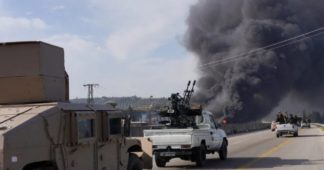By: Adonis Qabbani
Oct 27, 2025
Raids have expanded across rural areas such as Al-Hamidiyah, Al-Muhajireen, Umm al-Azam, Fahel, Al-Mahfoureh, and Jabourin.
Featured Image: Syrian government security forces in Homs, 2025. X/ @MayadeenEnglish
Since early September, the Syrian city of Homs has been gripped by a surge of violence, killings, and kidnappings targeting civilians, turning it into a forgotten city ruled by chaos and fear.
The numbers alone reveal the scale of the tragedy: over 42 deliberate murders, claiming the lives of 32 young men, four women, three elderly men, and three children, along with 15 kidnappings, including two young women.
According to local sources, most perpetrators belong to Bedouin factions spread across the city, often using motorcycles during their crimes. Others are reportedly members of the General Security Directorate, accused of executing civilians at checkpoints for sectarian reasons.
Security Chaos and Official Complicity
Local authorities in Homs have shown no serious effort to address this collapse in public safety. No arrests, no investigations, no deterrent measures — as if what is happening were none of their concern.
Meanwhile, arbitrary arrests and raids have expanded across rural areas such as Al-Hamidiyah, Al-Muhajireen, Umm al-Azam, Fahel, Al-Mahfoureh, and Jabourin, as well as Talkalakh and Al-Qusayr.
Behind the Chaos: Power Struggles and Social Collapse
The security chaos in Homs cannot be understood in isolation from the broader struggle for influence within the regime itself or from the social and economic fragmentation that has afflicted the city in recent years.
Local militias, which are supposed to operate under the state’s umbrella, now compete for control over neighborhoods and main roads, driven by financial interests and the smuggling of fuel and food supplies, while residents live between the hammer of fear and the anvil of poverty.
This gradual erosion of the concept of “the state” has made weapons the only guarantee of security, and loyalty — rather than competence — the standard for survival. Homs has thus become a microcosm of Syria itself: a country torn between competing authorities that share the destruction while leaving civilians to face their fate alone.
In a heartbreaking act of senseless violence, two young Alawite girls, Hanin Raslan (14) and Ghazal Raslan (13), were assassinated by gunmen on a motorcycle near the Workers’ Stadium in Homs.
These orphaned sisters from the village of Al-Dhahabiyah… pic.twitter.com/0b3monGtYe
— Ali Moheyaldeen (@ShowsAli) October 22, 2025
Organized Terror and Silent Demographic Change
Beyond lawlessness, Homs is witnessing what appears to be a targeted campaign of intimidationwith sectarian motives.
Armed men have been throwing grenades at homes in neighborhoods such as Al-Nazihin, Al-Sabeel, Al-Muhajireen, Karm al-Zeitoun, and Al-Zahraa — mostly Alawite-majority areas — to terrorize residents and force them to flee. This organized violence seems designed to alter the city’s demographic fabric through fear and forced displacement.
A City Without a State
What is happening in Homs today is not a passing phase of unrest, but a stark manifestation of state collapse in areas supposedly under government control.
When a city once known as the “capital of the revolution” becomes a stronghold of fear, and when justice is replaced by loyalty, Homs becomes a dark mirror reflecting the fate of all Syria.
Homs has been abandoned — just like the Syrian people were long ago. While regional powers redraw their zones of influence, the blood of civilians remains the only fuel keeping this endless nightmare alive.
The new Syrian president, Ahmed al-Sharaa, previously considered a terrorist, and his participation in the 80th UN General Assembly, in addition to his past as an Islamist rebel leader, and his current legitimacy on the international stage.#UNGA #Syria #AhmedAlSharaa #teleSUR pic.twitter.com/nSh8TyZsij
— teleSUR English (@telesurenglish) September 29, 2025
.
We remind our readers that publication of articles on our site does not mean that we agree with what is written. Our policy is to publish anything which we consider of interest, so as to assist our readers in forming their opinions. Sometimes we even publish articles with which we totally disagree, since we believe it is important for our readers to be informed on as wide a spectrum of views as possible.











